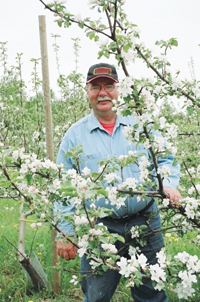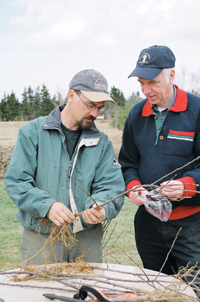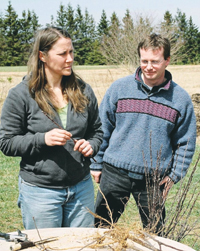
Features
Production
Research
Interest in organic apple production building in P.E.I.
building in P.E.I
March 12, 2008 By Kathy Birt
Valley, P.E.I., resident Margie Loo refers to herself as an “impostor” when it comes to being an organic apple producer.
 |
| Barry Balsom of Arlington Orchards manages 30 acres of apples. Among his plantings are about 1,000 Honeycrisp trees, considered one of the most popular apple varieties on the Island. Photo by Kathy Birt
|
 |
| Kentville Research Station scientist Charlie Embree (left) and Mark Ashley during a 2005 grafting workshop held at Wintermoor Orchards. Photo by Kathy Birt |
 |
| Valley, P.E.I., organic grower Margie Loo (left) and Chris Jordan take part in an apple workshop held in 2005 at Wintermoor Orchard. Photo by Kathy Birt |
Valley, P.E.I., resident Margie Loo refers to herself as an “impostor” when it comes to being an organic apple producer.
She may have “just” 40 organic apple trees but with another 12 acres of organic produce and eight years of certification under her belt, Loo may be the catalyst motivating about 15 to 20 conventional apple growers to switch to organic production methods.
Loo grows a variety of vegetables and fruit on her Elderflower Organic Farm. She also specializes in salad greens, growing them year-round in her four greenhouses. She sells all of her products weekly at the Charlottetown Farmers’ Market, which has proven to be the perfect venue for her organic apples.
With about six different varieties of scab-resistant organic apples in her orchard, Loo has traditionally made the apples into cider or sold them off the farm to restaurants or at the market.
“Last year was the first year I really felt like I had good yields,” she says. “With traffic increasing at the market every year, this may be where I market all my apples.”
Loo is part of a family that has been growing organically since 1995. She believes the time is “ripe” for growers to look hard at organic production. “Organic is becoming less scary to think of. It’s obvious there is a market and people can earn a living from it.”
During March 2007, about 29 apple producers from around the Maritimes – including Loo and 10 other producers from P.E.I. – attended a two-day workshop at the Kentville Research Station in the Annapolis Valley of Nova Scotia. Participants ranged from large growers to small operations where people are just starting to grow apples.
“I already know most of what the options are for organic, but I was just trying to learn more about production in general,” says Loo.
Among those attending was Mark Ashley, who owns Wintermoor Orchards, a farm of about 1,300 trees, along with his wife, Heather Taweel.
“It may sound very romantic to be growing organically but it may not be any better for the environment,” he says. “The consumer may like to buy organic produce in the supermarket, but if those organic apples came all the way from California, the chemicals (emissions) in getting them transported here takes away from the organic concept.”
Ashley says he believes consumers need to identify they are looking for disease-resistant apple varieties and push supermarkets to stock those varieties.
“If this was happening, we would consider going organic at Wintermoor,” he says.
Barry Balsom, who farms 30 acres of apples near Arlington, P.E.I., put a different twist on the idea of organics. “I don’t think there really (are) any conventional apple growers in Canada,” he says. “We all practice safe growing methods and have different forms of tree management of our orchards.”
He adds that he found the Kentville workshop challenging and believes growers who took part will look at their orchards a lot differently.
Topics covered during the workshop included:
• selecting a suitable site for organic apple production,
• choosing rootstock and organic cultivars for organic production,
• soil health,
• designing an organic orchard production system,
• controlling orchard diseases within organic guidelines,
• controlling insects,
• fertility,
• spraying,
• harvest and
• storage
"It was all of what growers needed to know to get started and very important first steps,” says Charlie Embree, a research scientist at the Kentville Research Station and one of the planners of the event. Initially, when he and his colleagues began to plan the workshops, they wondered if they would even get three people. “Feedback was wonderful,” says Embree.
“Demand for organic is strong and most growers already have some scab resistant varieties to start out with. We need to encourage their transition.”
Loo admits it would be hard for an established commercial apple producer to immediately shift all of their production to organic. Instead, growers should start the organic shift with a small orchard plot, allowing them to still have income from their conventional crop.
“They can gradually build up their alternative markets,” she says. “There are a lot of new techniques to learn for conventional growers to convert. I don’t think any big grower will convert an entire orchard all at once.”
For conventional growers to contemplate the process of going organic, they would be required to count forward 36 months from their last recorded chemical application to the orchard.
“That’s when they would harvest their first organic apples,” explains Susan MacKinnon, organic development officer with the P.E.I. Department of Agriculture, Fisheries and Aquaculture. “So, if they applied a prohibited chemical last October, their first harvest organically, would be in the fall of 2010.”
She adds that most P.E.I. apple growers have long been involved in production programs, such as integrated pest management (IPM) and integrated fruit production (IFP), involving minimal chemical applications.
“Apple growers have all learned to recognize certain pests and diseases and have orchards scouted and only apply pesticides when required,” notes
MacKinnon adds that in light of this, producers have a leg up on converting to organic. “It will also open up a new market for them.”
The province’s IFP program, which is administered by the P.E.I. Commercial Apple Growers’ Association, was started in 2006 and has provided Island apple growers an opportunity to address consumer concerns regarding pesticide usage while also better defining their product. A five-member board supervises the IFP program, in conjunction with the apple growers, and growers are assessed based on their production practices and commitment to upgrading their skills. Points are awarded based on:
• orchard land improvement,
• varying pesticides used,
• pruning to control pests,
• undertaking soil and leaf analysis and
• monitoring for pests on a regular basis.
Points are also awarded for attendance at workshops and for taking part in the annual orchard tour. A crop scout with the P.E.I. Horticulture Association visits growers weekly to assure all criteria is met. The primary objective of the program is to reduce chemicals, hence spray records are checked along with everything else.
Apple growers need to earn 375 points or better out of 600 in order to sell under the association’s label.
Print this page